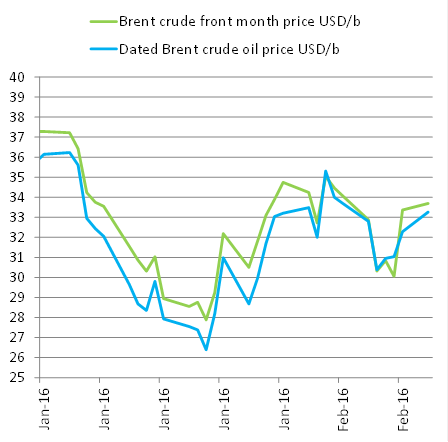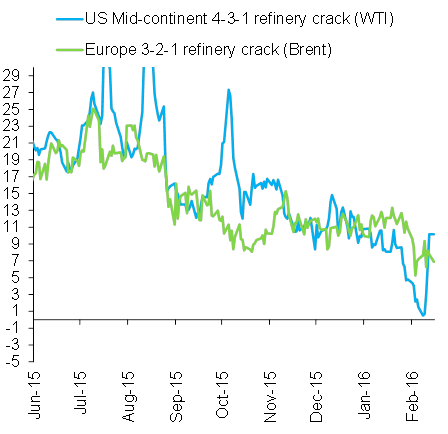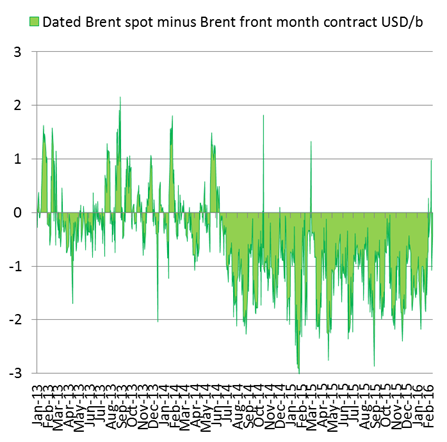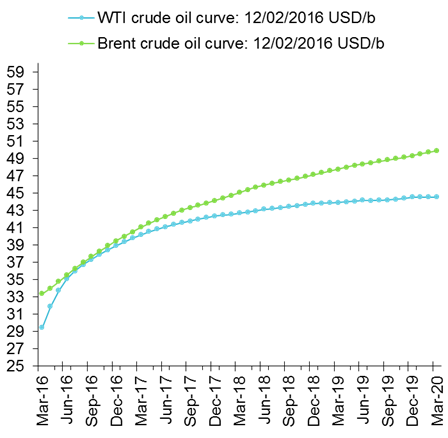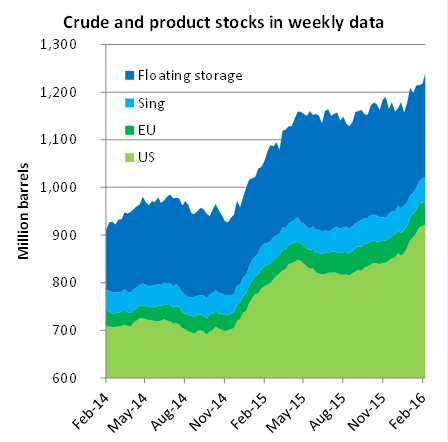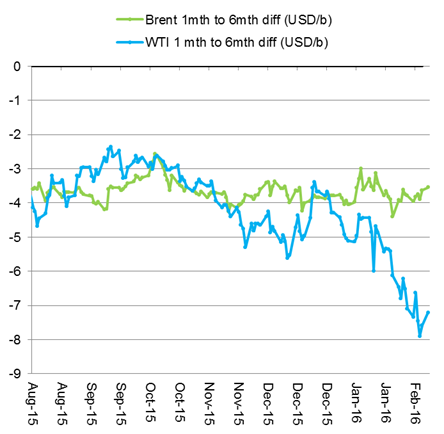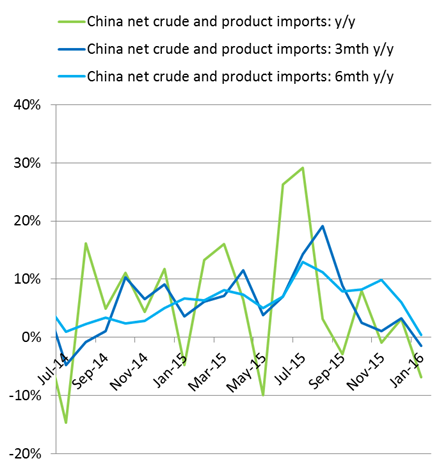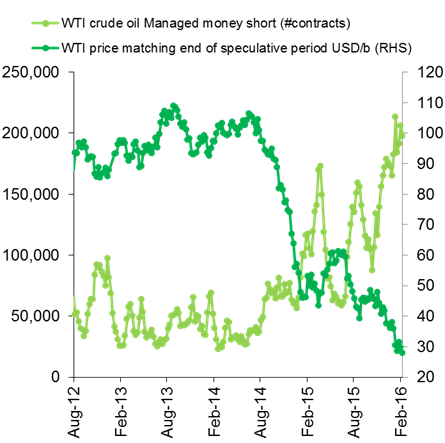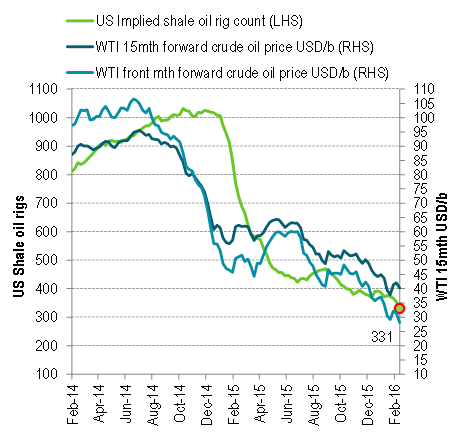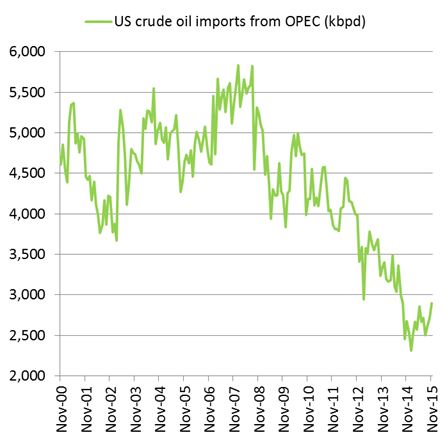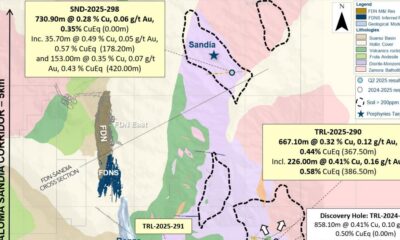Analys
Crude oil comment – Violent moves on the back of noisy fundamentals

 Crude oil comment – Violent moves on the back of noisy fundamentals
Crude oil comment – Violent moves on the back of noisy fundamentals- Graph 1: Brent crude oil price did not challenge the low from January
- Graph 2: US mid-Continental cracks declines to almost zero before cuts in refinery runs lifts the crack back up
- Graph 3: Dated Brent price moved to a one dollar premium to Brent front month
- Graph 4: Brent curve with reduced contango, but WTI curve shouts: “Store your oil somewhere else. We are full and it is expensive to store oil here”
- Graph 5: Global oil inventories are still rising quite solidly
- Graph 6: Temporary softer Contango likely to deepen again in both the Brent and the WTI curve
- Graph 7: Disappointing net crude and product imports to China for January (down 6.8% y/y in Jan)
- Graph 8: Speculative short positions in WTI are close to record high – makes a setting for violent false rallies
- Graph 9: US rig count is falling steeply in response to lower prices
- Graph 10: US crude oil imports from OPEC on the rise
Crude oil comment – Violent moves
Brent crude oil gained 11% to $33.36/b and WTI gained 12.3% to $29.44/b on Friday. And on what? It was not all that easy to identify, but there are of course a few moving parts which can be pieced together. One bearish driving force lately has been the deteriorating refining cracks in both Europe and the US. US refining margins in the US mid-continent almost went to zero recently as crude oil surplus increasingly has been transferred to a product surplus. This steep decline signalled a reduction in refining activity both in the US and in Europe ahead which would lead to increased stock building of crude oil. This would be especially acute in the US mid-continent with already high inventories. This is especially so in Cushing Oklahoma where stocks are close to maximum capacity. After having moved almost to zero on Monday a week ago the mid-continent cracks did however move into a solid recovery lifted by stronger product prices in the US in response to reduced refining activity. This probably did give some support to crude oil prices as well.
Another element was that the Dated Brent spot price moved to a one dollar premium to the front month Brent crude oil contract in a sign of some kind of temporary tightness in the physical crude oil market in the North Sea. The spot price has been in solid discount to the Brent 1 month price all since the global crude oil market moved into surplus in mid-2014. We do think that this supportiveness in the Dated Brent price is of temporary nature due to the still robust global stock building.
The exact details for what drove Dated Brent to a premium of front month Brent last week we don’t know. Typically these events are connected to balance and trading of physical cargoes. It was the biggest mark-up for Dated over the front month contract since March 2015 and clearly gave some bullish impetus to the financially traded oil market at the end of last week. The Dated Brent price is now however back to half a dollar discount to the front month price. The average discount has however been more than one dollar since mid-2014. Also today we have this slight bend in the Brent forward curve as a reflection of some kind of physical tightness in the Brent crude oil market and the Dated price has still not moved back to its “normal” one dollar discount to the front month price which has been the norm since mid-2014.
We believe that we are still in the midst of a stock building phase with growing oil inventories and deepening contango with still some time to go. However, we are also in a rebalancing period. What drove down US crude oil imports from 2007 was declining demand to start with. Thereafter imports declined yet further as US shale oil production rallied from 2011 onwards. US oil consumption is now instead increasing while US crude oil production is declining even though not steeply. US imports of crude oil from OPEC has now probably bottomed out and the tide is gradually turning towards a rise in imports instead.
For now however, we are still amidst a global stock building situation with a solid running surplus of oil. At least that is the calculation. One always needs to be humble to the fact that one do not really know the actual oil market balance. We have partial information about the supply/demand balance as well as global oil inventories. Oil prices however we do know and they are a reflection of both financial flows as well as physical fundamentals. The price picture can however be quite deceiving due to temporary effects and financial flows. The firming Dated Brent price versus the front month price is typically something which we would witness once the market starts to firm up. As such it is important to take note of last week’s event as well as today’s also fairly small Dated discount to the front month contract. For now however we believe it is a temporary event rather than signalling the start of a rapidly tightening situation.
The big jump in crude oil prices we experienced end of last week may have been instigated by changes in refining margins or physical spot prices or rumours for potential joint production cuts by OPEC and Russia. However, the magnitude of bounce was clearly driven by financial flows and potentially short covering. Speculative short positions (as depicted by shorts by managed money) are very high. Thus price moves to the upside are likely to be violent due to short covering when they happen.
Brent crude oil price did not challenge the low from January
US mid-Continental cracks declines to almost zero before cuts in refinery runs lifts the crack back up
Dated Brent price moved to a one dollar premium to Brent front month
Probably on the back of temporary tightness on the back of physical trading of cargoes.
Brent curve with reduced contango, but WTI curve shouts: “Store your oil somewhere else. We are full and it is expensive to store oil here”
Thus reduced US oil imports and softer stock building in the US may be the consequence.
It basically means that stock building will have to take place somewhere else.
Global oil inventories are still rising quite solidly
There is little sign of any weakening in the current ongoing stock building.
Thus the recent reduction in contango should be temporary.
Floating storage is mostly oil in transit rather than financially driven deliberate storage of oil
Temporary softer Contango likely to deepen again in both the Brent and the WTI curve
Disappointing net crude and product imports to China for January
Y/y it declined 6.8%. For 3 mth y/y it declined 1.4% and 6mth y/y only saw a growth of 0.4%
Speculative short positions in WTI are close to record high – makes a setting for violent false rallies
Thus short covering kicking in when the oil price ticks higher is likely to lead to moves in prices like we saw end of last week
US rig count is falling steeply in response to lower prices
US oil rigs have declined by 99 rigs over the last seven weeks while implied US shale oil rigs have declined by 61 rigs. This loss of 61 shale oil rigs cuts some 200 – 250 kbpd from the supply balance on a 12 mths horizon.
US crude oil imports from OPEC on the rise
Kind regards
Bjarne Schieldrop
Chief analyst, Commodities
SEB Markets
Merchant Banking
Analys
OPEC+ in a process of retaking market share

Oil prices are likely to fall for a fourth straight year as OPEC+ unwinds cuts and retakes market share. We expect Brent crude to average USD 55/b in Q4/25 before OPEC+ steps in to stabilise the market into 2026. Surplus, stock building, oil prices are under pressure with OPEC+ calling the shots as to how rough it wants to play it. We see natural gas prices following parity with oil (except for seasonality) until LNG surplus arrives in late 2026/early 2027.

Oil market: Q4/25 and 2026 will be all about how OPEC+ chooses to play it
OPEC+ is in a process of unwinding voluntary cuts by a sub-group of the members and taking back market share. But the process looks set to be different from 2014-16, as the group doesn’t look likely to blindly lift production to take back market share. The group has stated very explicitly that it can just as well cut production as increase it ahead. While the oil price is unlikely to drop as violently and lasting as in 2014-16, it will likely fall further before the group steps in with fresh cuts to stabilise the price. We expect Brent to fall to USD 55/b in Q4/25 before the group steps in with fresh cuts at the end of the year.

Natural gas market: Winter risk ahead, yet LNG balance to loosen from 2026
The global gas market entered 2025 in a fragile state of balance. European reliance on LNG remains high, with Russian pipeline flows limited to Turkey and Russian LNG constrained by sanctions. Planned NCS maintenance in late summer could trim exports by up to 1.3 TWh/day, pressuring EU storage ahead of winter. Meanwhile, NE Asia accounts for more than 50% of global LNG demand, with China alone nearing a 20% share (~80 mt in 2024). US shale gas production has likely peaked after reaching 104.8 bcf/d, even as LNG export capacity expands rapidly, tightening the US balance. Global supply additions are limited until late 2026, when major US, Qatari and Canadian projects are due to start up. Until then, we expect TTF to average EUR 38/MWh through 2025, before easing as the new supply wave likely arrives in late 2026 and then in 2027.
Analys
Manufacturing PMIs ticking higher lends support to both copper and oil

Price action contained withing USD 2/b last week. Likely muted today as well with US closed. The Brent November contract is the new front-month contract as of today. It traded in a range of USD 66.37-68.49/b and closed the week up a mere 0.4% at USD 67.48/b. US oil inventory data didn’t make much of an impact on the Brent price last week as it is totally normal for US crude stocks to decline 2.4 mb/d this time of year as data showed. This morning Brent is up a meager 0.5% to USD 67.8/b. It is US Labor day today with US markets closed. Today’s price action is likely going to be muted due to that.

Improving manufacturing readings. China’s manufacturing PMI for August came in at 49.4 versus 49.3 for July. A marginal improvement. The total PMI index ticked up to 50.5 from 50.2 with non-manufacturing also helping it higher. The HCOB Eurozone manufacturing PMI was a disastrous 45.1 last December, but has since then been on a one-way street upwards to its current 50.5 for August. The S&P US manufacturing index jumped to 53.3 in August which was the highest since 2022 (US ISM manufacturing tomorrow). India manufacturing PMI rose further and to 59.3 for August which is the highest since at least 2022.
Are we in for global manufacturing expansion? Would help to explain copper at 10k and resilient oil. JPMorgan global manufacturing index for August is due tomorrow. It was 49.7 in July and has been below the 50-line since February. Looking at the above it looks like a good chance for moving into positive territory for global manufacturing. A copper price of USD 9935/ton, sniffing at the 10k line could be a reflection of that. An oil price holding up fairly well at close to USD 68/b despite the fact that oil balances for Q4-25 and 2026 looks bloated could be another reflection that global manufacturing may be accelerating.
US manufacturing PMI by S&P rose to 53.3 in August. It was published on 21 August, so not at all newly released. But the US ISM manufacturing PMI is due tomorrow and has the potential to follow suite with a strong manufacturing reading.
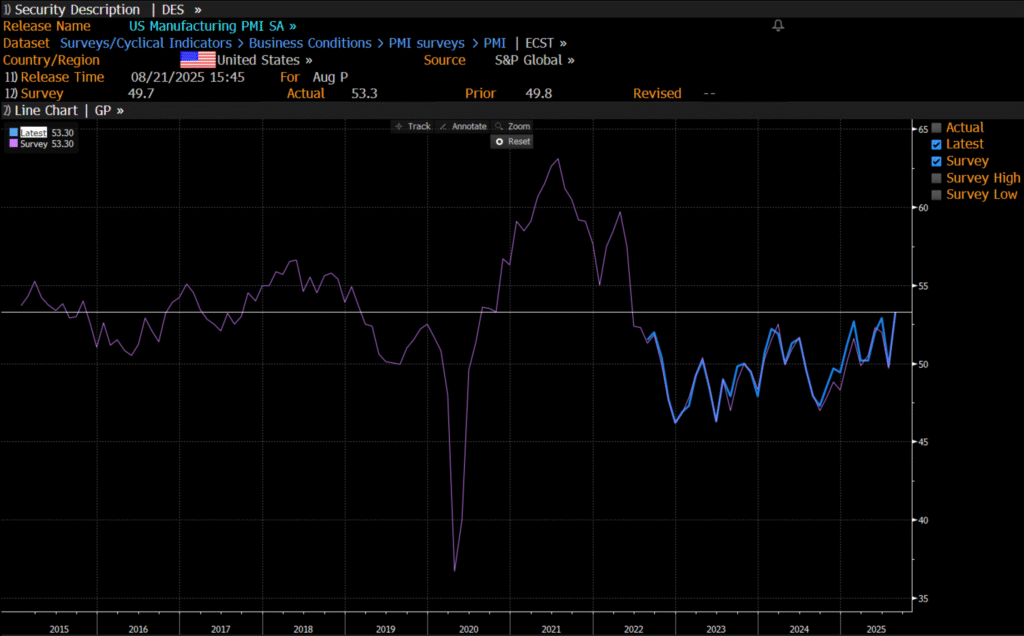
Analys
Crude stocks fall again – diesel tightness persists

U.S. commercial crude inventories posted another draw last week, falling by 2.4 million barrels to 418.3 million barrels, according to the latest DOE report. Inventories are now 6% below the five-year seasonal average, underlining a persistently tight supply picture as we move into the post-peak demand season.

While the draw was smaller than last week’s 6 million barrel decline, the trend remains consistent with seasonal patterns. Current inventories are still well below the 2015–2022 average of around 449 million barrels.
Gasoline inventories dropped by 1.2 million barrels and are now close to the five-year average. The breakdown showed a modest increase in finished gasoline offset by a decline in blending components – hinting at steady end-user demand.
Diesel inventories saw yet another sharp move, falling by 1.8 million barrels. Stocks are now 15% below the five-year average, pointing to sustained tightness in middle distillates. In fact, diesel remains the most undersupplied segment, with current inventory levels at the very low end of the historical range (see page 3 attached).
Total commercial petroleum inventories – including crude and products but excluding the SPR – fell by 4.4 million barrels on the week, bringing total inventories to approximately 1,259 million barrels. Despite rising refinery utilization at 94.6%, the broader inventory complex remains structurally tight.
On the demand side, the DOE’s ‘products supplied’ metric – a proxy for implied consumption – stayed strong. Total product demand averaged 21.2 million barrels per day over the last four weeks, up 2.5% YoY. Diesel and jet fuel were the standouts, up 7.7% and 1.7%, respectively, while gasoline demand softened slightly, down 1.1% YoY. The figures reflect a still-solid late-summer demand environment, particularly in industrial and freight-related sectors.
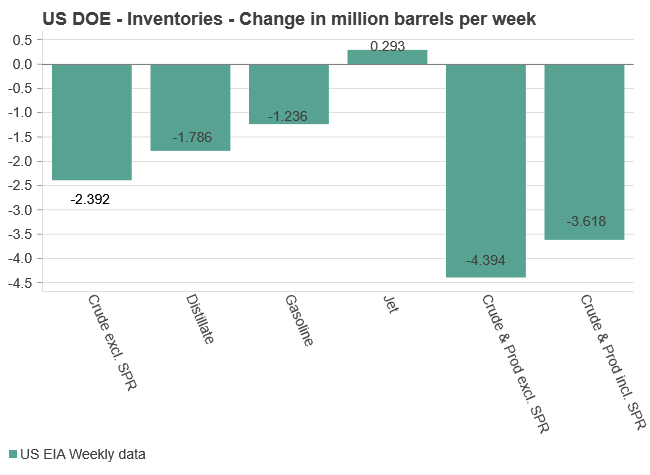
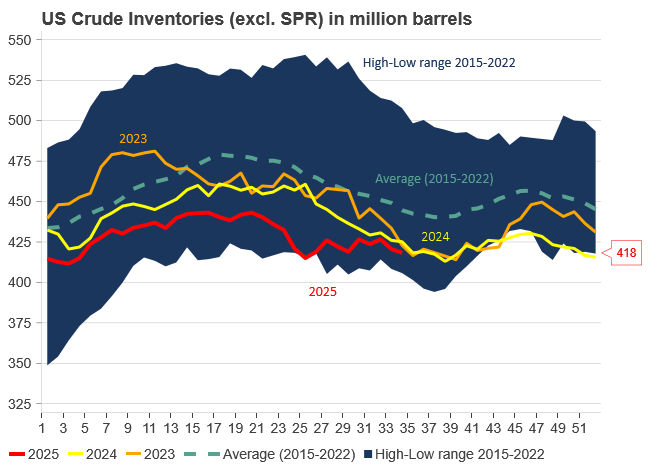
-

 Nyheter4 veckor sedan
Nyheter4 veckor sedanOmgående mångmiljardfiasko för Equinors satsning på Ørsted och vindkraft
-

 Nyheter2 veckor sedan
Nyheter2 veckor sedanMeta bygger ett AI-datacenter på 5 GW och 2,25 GW gaskraftverk
-

 Nyheter4 veckor sedan
Nyheter4 veckor sedanGuld stiger till över 3500 USD på osäkerhet i världen
-

 Analys4 veckor sedan
Analys4 veckor sedanWhat OPEC+ is doing, what it is saying and what we are hearing
-

 Nyheter2 veckor sedan
Nyheter2 veckor sedanAker BP gör ett av Norges största oljefynd på ett decennium, stärker resurserna i Yggdrasilområdet
-

 Nyheter4 veckor sedan
Nyheter4 veckor sedanLyten, tillverkare av litium-svavelbatterier, tar över Northvolts tillgångar i Sverige och Tyskland
-

 Analys3 veckor sedan
Analys3 veckor sedanBrent sideways on sanctions and peace talks
-

 Nyheter3 veckor sedan
Nyheter3 veckor sedanEtt samtal om koppar, kaffe och spannmål


